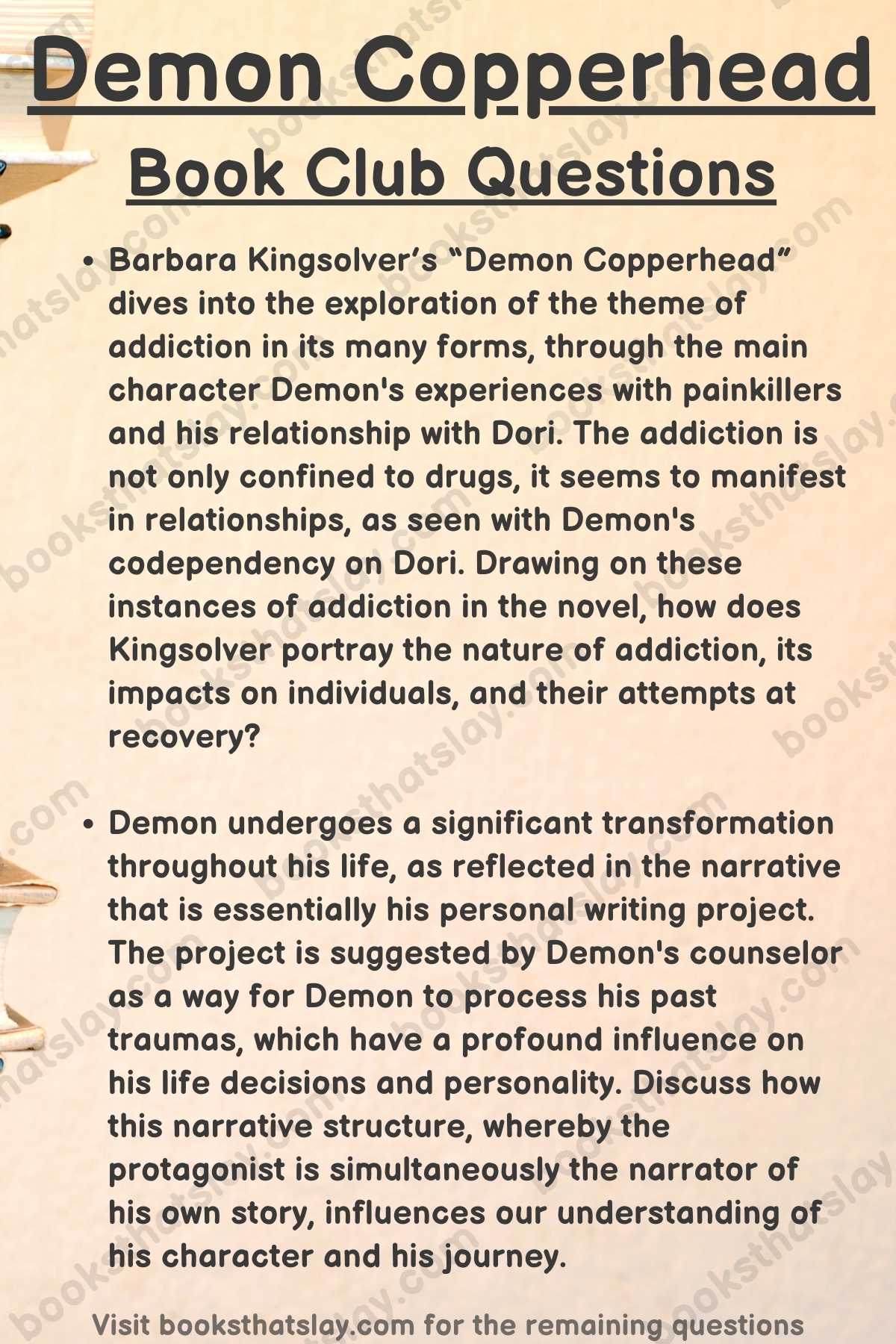10 Demon Copperhead Book Club Questions For Discussion
Demon Copperhead isn’t your typical grandma’s fairytale. We’re following a tough kid named Demon who starts out roughing it in a trailer with his struggling mom.
With his dad’s good looks, fiery hair, and sharp wit, Demon fights his way through a wild ride. From bouncing around foster care to working crummy jobs, Demon faces heartbreak and tough choices. All the while, he’s battling the feeling of being invisible in a world that’s forgotten about small towns.
Sound familiar? This story is inspired by Charles Dickens’ classics, but with a modern twist. Author Barbara Kingsolver crafts a tale that anyone who’s ever felt lost or stuck in their hometown can relate to.
Ready to dive deep after knowing the basics?
We’ve got some awesome discussion questions to get your book club buzzing about Demon Copperhead. Get ready for a journey of triumph, tragedy, and the power of storytelling, all while exploring the challenges faced by those on the margins.

Demon Copperhead Book Club Questions
- Throughout the novel, how does the protagonist’s character evolve in response to the adversities he faces, such as abuse, addiction, and loss? What specific events or relationships contribute most significantly to Demon’s growth and resilience? How does the portrayal of Demon’s inner struggles and external challenges contribute to the novel’s exploration of the individual’s capacity for resilience in the face of systemic failures?
- The text mentions the influence of Charles Dickens’s “David Copperfield” on “Demon Copperhead.” In what ways does Barbara Kingsolver employ elements of Dickensian storytelling and social critique in her novel? How does this intertextual relationship deepen the thematic exploration of societal issues and the individual’s struggle for agency and redemption in contemporary America?
- “Demon Copperhead” dives into the failures of American institutions, including the foster care system, healthcare, education, and law enforcement. How does Kingsolver use Demon’s experiences to critique these institutions and highlight the systemic challenges faced by marginalized individuals, particularly in rural communities? How do these critiques resonate with broader societal debates and issues?
- The novel addresses themes of identity, including gender identity and sexual orientation, as well as the intersections of poverty, addiction, and race. How do characters like Angus, Maggot, and Emmy navigate their identities within the context of their socio-economic backgrounds and personal struggles? How does Kingsolver handle the portrayal of marginalized identities, and what commentary does she offer on the complexities of identity formation and acceptance?
- Analyze the significance of recurring motifs and symbols in the novel such as water, the ocean, the Devil’s Bathtub, and the graphic novel Red Neck. How do these elements contribute to the novel’s thematic depth and character development? How does Kingsolver utilize symbolism and metaphor to enhance the reader’s understanding of the protagonist’s journey and the broader social issues explored in the narrative?
- Throughout the novel, characters face numerous ethical dilemmas and moral challenges, often stemming from their socio-economic circumstances and personal relationships. Explore the ethical decisions made by characters like Demon, Maggot, and Emmy, considering their motivations, consequences, and the broader moral landscape depicted in the narrative. How does Kingsolver navigate the complexities of morality and ethical responsibility in a world marked by systemic injustices and individual struggles?
- Discuss the significance of interpersonal relationships and community dynamics in the novel, particularly the role of chosen families, mentorship, and support networks in shaping the characters’ lives. How do characters like Mrs. Peggot, Coach Winfield, and Aunt June serve as mentors or surrogate parents for Demon and others? How do these relationships reflect broader themes of resilience, compassion, and the search for belonging in the face of adversity?
- Trauma is a central theme in the novel, affecting multiple characters in different ways. Analyze the portrayal of trauma and its long-term effects on characters like Demon, Dori, and Maggot. How do these characters cope with their trauma, and what strategies do they employ to pursue healing and recovery? How does Kingsolver depict the complexities of trauma and the journey toward emotional and psychological well-being?
- Examine the power dynamics and social hierarchies depicted in “Demon Copperhead,” including those based on socio-economic status, gender, and age. How do characters navigate these power dynamics, and what strategies do they employ to resist or subvert oppressive structures? How does the novel challenge traditional notions of power and authority, particularly in the context of rural America?
- The novel is set in Appalachia, a region known for its natural beauty and environmental challenges. Discuss the portrayal of the Appalachian landscape and its significance in the narrative. How does Kingsolver explore environmental themes such as land exploitation, pollution, and the relationship between humans and nature? How do these themes intersect with the broader socio-economic and cultural issues addressed in the novel?
Read our other discussion guides